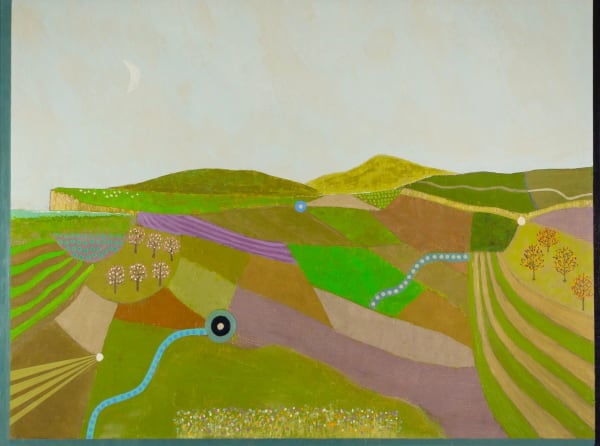Tim Woolcock b. 1952
Tim Woolcock was born in Lancashire, though his family originates from St Just-in-Penwith in Cornwall, where the artist spent many summers. He now lives part of the year on his farm in County Carlow, Ireland, where his studio is located.
Between 1963 and 1970 Tim attended Arnold School in Blackpool and regularly visited the Grundy Art Gallery in the town. In 1971, he began his studies in to study Philosophy and Art at the Roehampton Institute, University of London. After graduating, Tim stayed in London to teach for twelve years.
Tim's painting clearly shows his inspiration from Modern British painters, particularly the traditions of the 1950s and St Ives Schools. As with landscape painters of the earlier twentieth century, such as Paul Nash and Evelyn Dunbar, Tim's landscapes have a somewhat mystical quality and at times approach abstraction. The simplicity and geometry found in work of the St Ives School - so important to the development of Modern British art - is a particular inspiration, with artists such as Patrick Heron, William Scott and Ben Nicholson being most key in his development, though Tim's paintings have a strength and clarity all their own. A knowledge of Zen and understanding of the natural world is reflected in his work,
'I have been greatly influenced by Zen writers, some who have said that the real aim of art is purposeless - not to be confused with a nihilistic approach - in 'Zen and The Art of Archery' it is said that in calligraphy strokes are made by the brush with perhaps the painter not fully being conscious of his or her efforts. I have found this to be true when painting, as if a certain effortless process is ignited where the self drops away and a painting manifests without a painter.'
His main subjects are landscapes and abstractions, taking his influences from the locale surrounding his studio in Ireland, where he takes his daily walks, and trips to the countryside of the UK. As with many painters who take landscape as their subject, Tim's works usually begins life as a series of sketches. However, it is the spirit of the place that determines his final outcome. It is the particular beauty of the British and Irish countryside that he seeks to convey in his landscape paintings.
Tim became drawn in by the contrasts between the coasts of Lancashire and Cornwall, two places he had felt an affinity with, home and the home of his ancestors. He later made a similar comparison between the countryside of England and his new home in Ireland. Tim said of this idea of comparative landscapes, 'when taking long walks in Dorset I have been enthralled by the sheer beauty and unspoilt scenery which one is afforded ... this contrasts sharply with the rugged magnificence of Dartmoor and the area of West Cornwall - with its tin mines - where my grandfather worked.'
The use of Michael Harding pigments, hand-made and strong in colour, make his painting particularly distinctive. His landscapes are made up of rich blocks of paint, often scratched or scored away to reveal the support, the tonalities of which are stitched together to create the patchworks of fields that he finds so interesting. The regular appearance of framing devices such as an aperture or a window can be seen in his landscape paintings.
Tim’s work can be found in private collections in the UK, Ireland and internationally. In 2009, the Office of Public Works in Dublin, Ireland acquired one of his paintings for the Department of Arts, Heritage and the Gaeltacht.
"The scale and proportions of his work present an internal harmony, and this mood is completed in the delicate balance between form and the exquisite colours he uses. We see lyrical lines and geometric fragmented shapes. Woolcock has seemed to show an interest in Cubism and a wonderful sense of contour and drama. There is a meditative serenity in his colour variations which perhaps reflects the contemplative personality of Woolcock himself and his landscapes evoke the beauty and grandeur of the Irish Countryside".
Joanna Pitman, art critic for London Times




